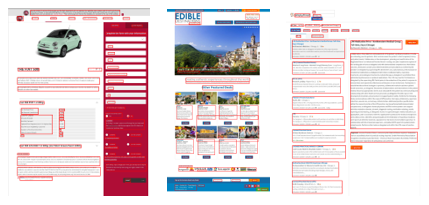
![]() Insights
Insights
Machine learning can solve problems more efficiently and effectively than humans, which means increased performance and reduced costs for businesses. In this article, we run through ways brands can use machine learning to drive results, and three algorithms we have built to provide solutions for our clients.
Machine learning and artificial intelligence (AI) are often used interchangeably, but they are not the same thing. AI is a broad concept referring to machines which uses algorithms to complete a task in an ‘intelligent’ way.
Machine learning is a subset of AI – so while machine learning is artificially intelligent, not all AI is machine learning. Machine learning involves supplying a machine with data which it then uses to teach itself an algorithm by comparing the data to find patterns and trends. The machine continually learns, and as it receives new data it updates the algorithm to reflect changing trends.
While artificial intelligence has become a hot topic in mainstream media, machine learning is becoming more enticing to digital marketers. We can use machine learning to build bespoke marketing solutions more quickly and efficiently than ever.
Machines can analyse huge data sets and identify patterns much quicker than humans, which means we can solve problems and implement solutions faster, to achieve better results.
Many brands already use machine learning to improve their digital efforts. Netflix, for example, uses machine learning to personalise each individual account – not only using your past activity to customise what recommended programmes to watch, but going so far as to personalise the images it uses to increase your likelihood of selecting what to watch.
Chat bots are another way brands are using machine learning to deliver better customer experiences. Machine learning chatbots collect data from each conversation and use this to provide more relevant and accurate responses to customer queries, rather than only using pre-programmed auto responses.
Smart bidding is a type of automated bidding strategy that uses machine learning to improve the performance of paid media campaigns. The machine uses historical campaign data to see how a wide range of signals impact performance and adjusts bids at each auction based on these signals. Google Ads, Search Ads 360 and Display & Video 360 all allow for smart bidding, and all have been shown to improve performance over manual bidding.


While machine learning solutions can be built for almost any problem, there is one prerequisite – we need an abundance of high-quality data for the machines to build reliable algorithms. For brands, this often means going through the process of setting up data capture, cleansing existing data, and bringing multiple data sources into one central infrastructure, before it is feasible to build a machine learning tool.
Along with helping clients carry out data cleansing, we have built several machine learning tools to support with digital marketing processes.
We have built a machine learning tool that uses Google’s Universal Sentence Encoder to measure how relevant webpage content is to the key search terms being targeted.

While there are many content checking tools out there, none take into consideration the visual cues used by humans and search engines to understand web content. We trained a TensorFlow deep learning model to predict the likelihood of a given text-block forming part of main page content and factoring in multiple features about the text block (such as size, page location, text size and text density) and the webpage layout itself.
We created a huge labelled data set of text blocks and their corresponding page images by getting the team to look over page images and classify if a text block formed the main webpage content or not.
One of our clients generates leads via their website that are then nurtured offline until sale. There are several types of leads generated including brochure requests and showroom bookings, and the final sale value of the lead understandably varies depending on the lead’s type of request, customer demographic, and their online behaviour.
The lead time between a visitor submitting an enquiry to making a purchase was several weeks. Not only does this make using actual sales to target auto-bidding less effective, it meant we were unable to respond quickly to campaigns that were driving low quality leads.
We needed a way to predict the value of a lead, in real-time, so we could use this information in auto-bidding technologies. To do this, we trained a machine learning model to value form leads based on the eventual sale value from historical form submissions:
1. We analysed historical sales events and the form submissions that preceded them using a BigQuery machine regression model. This model took into account form features (such as store location and contact type) and the user’s onsite behaviour prior to filling in the form
2. We then used the trained model to estimate the value of newly submitted forms by taking the associated data and passing it through the trained model. This returns a predicted eventual sale value for the form fill
3. The value is sent back into Google Analytics using BigQuery’s measurement protocol where it can be used to feed into the client’s auto-bidding platform and create audiences to value post-enquiry, but pre-sale, users.
4. The model is retrained daily using the newly available data.



The same client also needed to be able to predict the ‘quality’ of users (in terms of how likely they were to eventually convert) better. A typical user would visit the website several times before submitting an enquiry, and not all visitors would convert into leads (or sales). It was important we were able to prioritise the remarketing budget towards the most valuable visitors with the highest chance of converting.
Machine learning allows us to identify the users that are most interested in the product, so we can place them in suitable audiences for retargeting.
We exported Google Analytics 360 (GA360) data into BigQuery and then built a custom recurrent neural network that we trained to use this dataset. The neural network trained a model to ‘score’ every session (even if they did not lead to an enquiry) based on all behaviour events, such as pageviews for each user in the current and previous sessions, and the meta data for those events and pages.
After a session is ‘scored’, we pushed the event back into Google Analytics, along with custom dimensions and metrics, describing the probability to submit a form in the future and its likely value. This is pushed back through Google Analytics within four hours of the session, meaning we hit timestamp to associate the event as part of the original session, and can get a session scoped dimension against that session, as well as the place metrics in the session ‘score’.
We can now create audiences for the different tiers of website users, based on how likely they are to convert, and target users with a higher chance of buying more aggressively. This is a more efficient and effective way of using the client’s remarketing budget and means we can deliver a higher ROI.
Machine learning can be a great tool to improve your digital marketing efforts. However, a machine learning model is only as good as the data it’s trained on. So, the first step to use machine learning in your digital marketing strategy is to make sure you have access to lots of high-quality data. This means there are certain steps you need to take before creating a machine learning model, such as:
Once your data is in order, you are in a good place to start building machine learning solutions for any big data problems you have.
Want to implement machine learning?Contact us and our data scientists can help

![]() Insights
Insights

![]() Insights
Insights

![]() Insights
Insights